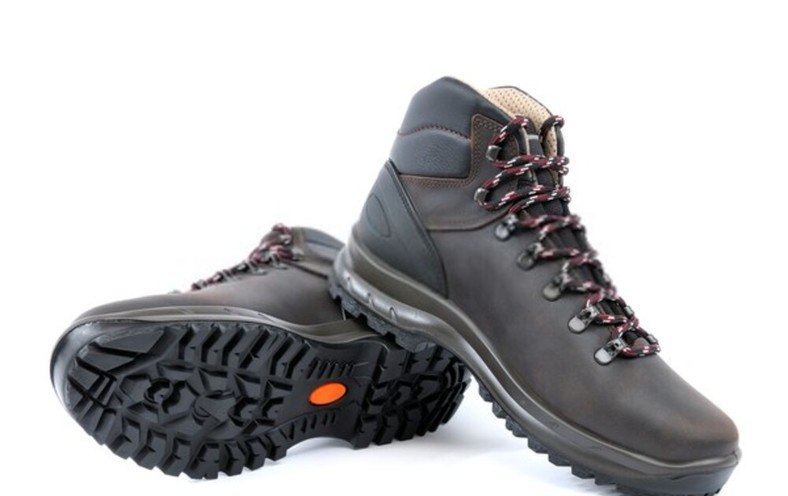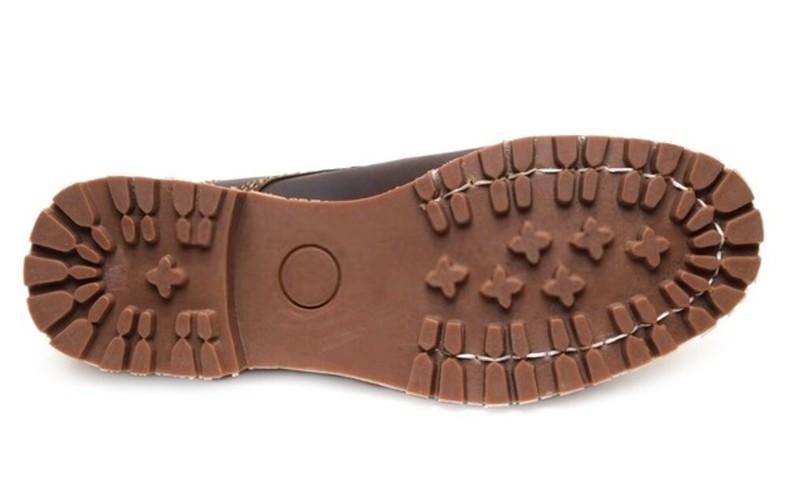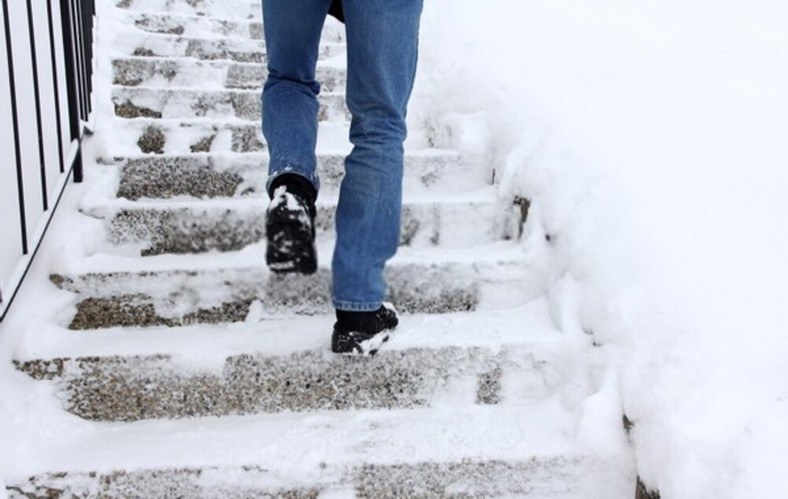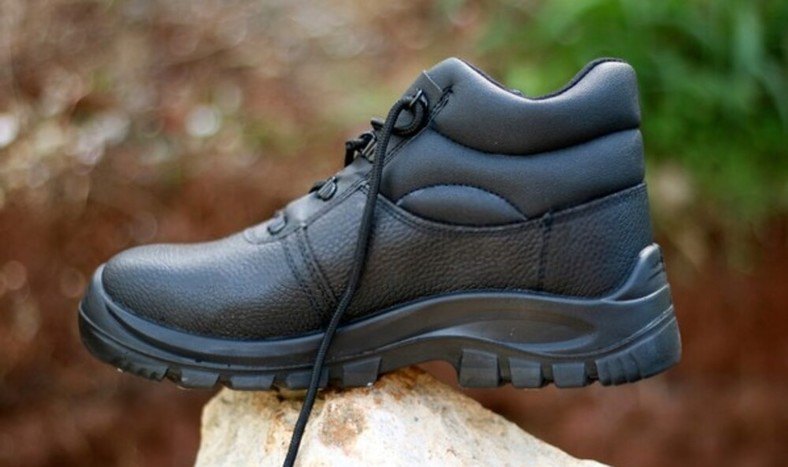How Do You Know if You Have Anti Slip Soles
How to tell if shoes are non-sideslip? According to the European regulation EN 20345, there are three standards concerning non-skid condom footwear. They are the SRA, SRB, and SRC standards. A non-skid safety shoe meets ane of the SRA or SRB or SRC standards.
Tabular array of Contents
- The SRA, SRB, and SRC standards
- How to tell If Shoes are Non-Slip?
- Scrutinize the tread patterns
- Check the soles
- Rounded soles are more than advantageous than flat soles
- Safe soles are always more slip-resistant than leather soles
- Look for Grooves
- Feel the Bottom
- Requite Them a Test Drive
- How To Make Shoe Sideslip-Resistant?
- Scuff Your Soles
- Apply Traction Spray
- Add a mixture of salt and prophylactic mucilage.
- Spray Hairspray on Soles
- Score The Shoes Bottoms
- Rub Sand To Your Soles
- Examination Water ice Grips
- Supersede the soles of your shoes
- Setup a new rubber base
- Examination Sandpaper
- Identify Band-Aids
- Make utilise of Puff Pigment
- Types of Non-Sideslip Shoes
- How to Choose a Not-Skid Piece of work Shoe?
- Why is Information technology Of import to Choose the Correct Safety Shoe?
- FAQs
The SRA, SRB, and SRC standards
SRA standard: Under the conditions provided for by the standard, the SRA standard certifies that the shoe is a non-slip on a ceramic flooring covered with h2o and detergent.
SRB standard: The SRB standard certifies that the shoes are non-slip on a steel floor covered with glycerin.
SRC standard: As for the SRC standard, it meets the weather of the SRA standard and the weather condition of the SRB standard at the aforementioned time. SRC standard shoes are ideal for workers in industry, send and logistics activities, plumbers, and construction trades.
They certify the non-skid capacity of the safety shoes depending on the type of ground. The SRC standard is the near comprehensive because the shoes come across both SRA and SRB requirements.
How to tell If Shoes are Non-Slip?
The one way to tell if shoes are non-sideslip is to wear them and walk on a non-slippery surface. If the soles of the shoe grip, then they're likely made with a rubber or other material that grabs and holds on. The next best selection is to hold onto something like a wall or fifty-fifty the door handle of the cabinet you're continuing in front of. If you don't have a proficient grip, either the original owner didn't take the time to rub or wax them to make them non-sideslip or yous're continuing on a surface that isn't very grippy.
Scrutinize the tread patterns
Nearly shoes fabricated for men and these days, for casual wearable as well, have some sort of tread blueprint on them. The tread blueprint is generally on the sole of the shoe and information technology'south usually a solid color that hasn't been stretched or stretched on purpose. If there isn't a tread pattern, they don't have much traction and they will not grip.
The first step would be to bank check the tread pattern. If there is a pattern on the sole of the shoe, then it is probable fabricated with a rubber or other textile that grabs and holds on. The next all-time option would be to hold onto something like a wall or even the door handle of the chiffonier you're standing in front end of. If at that place isn't an obvious tread pattern, they don't take much traction and they volition not grip.
Cheque the soles
Most shoes take rubber soles that are glued together at one time or some other to make it hard to separate them. If the soles are made of rubber and they're glued, if you accept a knife and divide the rubber, yous'll usually notice that it'south not glued at all.
The shape of the sole has a lot to practise with traction and grip. The most common shapes you'll see are circular and square. I personally similar the triangular-shaped soles with deep treads considering it makes them not skid on my anxiety if I'm wearing them outside.
Ask a specialist if the sole is rubber or some other substances: In the U.s.a., shoes are fabricated with many compounds similar rubber, PVC, and PU. And the rubber has the best non-slip elements.
Rounded soles are more advantageous than flat soles
Rounded soles are better than flat soles because they have a more defined edge. This edge will grab onto the surface improve than a apartment one volition exercise, therefore they're easier to slip on. Keep in mind that the more than grippy the sole of the shoe is, the less room there is for your feet to aggrandize one time they are inside of them. There are some shoes with soles that are smooth with no treads or grooves so they aren't very grippy either.
Rubber soles are always more sideslip-resistant than leather soles
Leather soles are the about common types of soles you'll find. The tough leather with the smooth surface comes from cows that live on the Serengeti plains in Africa. These leathers are usually processed into cowhide, but if you're worried virtually being allergic to it, they're usually sprayed with a solution of acrylic to prevent information technology from existence an allergen.
Expect for Grooves
The soles of the shoes could be grooved or patterned. Information technology depends on the shoe and the type of pattern. If it looks similar it's suited to be not-skid, then that'south another good indicator that it should have some traction on a slippery surface.
Feel the Bottom
The bottoms of shoes are ofttimes made with prophylactic or other materials that grab and hold on to something. If there isn't a condom bottom, then the shoe will not grip or grip very well.
Requite Them a Test Drive
Carry them around for a while to see how they work. You may not exist able to tell if the safety is glued or if it's already separated because the soles are rubber, only if not, you can tell if the shoe has any traction afterward testing it out for a few minutes.
Using oil, vinegar, or lather to examination: There are different products y'all can use to test the traction of your shoes. Vinegar or soap will work to go along them from slipping on certain surfaces. Oil is not that useful in this example considering information technology could but make the surface glace too.

Many people assume that when a shoe company puts the label with the terms of Slip Resistant Shoes, it means that the shoes are completely slip-resistant. It is a wrong mindset. Another one is that if the shoe bottom (sole) has a complex or weird pattern, it will grip better. Again, it is not e'er right!
There is no labeling standard for not-slip footwear in the U.s.a.. The sometime standards are outdated and have been withdrawn. The design of the tread will improve sideslip prevention. Many factors touch slip prevention.
How To Make Shoe Slip-Resistant?
Do you have a recurring nightmare of your shoes slipping off in the middle of the day while you are doing something important? Or maybe you just want to be prepared for any sort of outdoor or indoor activity?
Here are eleven Shoe Slip Resistant Hacks if you are in search of some creative solutions on how to make shoes slip-resistant:
Scuff Your Soles
Why do you accept to scuff the soles? Well, it's considering scuffing volition help you in creating a consummate bond between the condom sole and the upper. Showing that your shoes are sturdy in looks.
Apply Traction Spray
This is a uncomplicated to-do awarding that volition help y'all not only making shoes skid-resistant simply as well requite smoothness to your shoes. According to an online article, if your shoes are wearing out, traction spray could help you in rejuvenating the sole of the shoe.
Add together a mixture of salt and safe gum.
The ingredient of this mixture is created specially, to make shoes slip-resistant. The mixture is intended to give the sole an extra grip. How to do it? Start, you merely demand to mix equal amounts of salt and prophylactic cement together. So, spread the mixture evenly on the sole of your shoe.
Spray Hairspray on Soles
Spray hairspray on the soles of your shoes. This will help you to accomplish that slip-resistant wait. Then, rub it into the soles gently. This is a inexpensive and effective way to make shoes slip-resistant and shiny.
Score The Shoes Bottoms
Scoring the lesser of your shoes would help you in making them slip-resistant. When you score them, it creates lines on the bottom of the shoe and these lines will work equally a gripping blueprint, and then your shoes won't be slippery anymore.
Rub Sand To Your Soles
There are many ways that you could do this. Some of them are using epoxy, super glue, hairbands, etc. The only matter that you need to practice is to create a bail between the sole and the upper part of your shoe. You tin do this by simply sticking or gluing onto the lesser of your shoes.
Examination Ice Grips
Ice grips are adhesive substances that you lot could get past applying them under the sole of your shoe. A good case of this substance is the i plant on skate shoes or rollerblades. The reason why ice grips are constructive in making shoes skid-resistant is information technology provides a strong, not-stick surface so you volition go better traction and won't' slip off.
Supervene upon the soles of your shoes
You could e'er re-sole your shoes if they are already worn out. This stride is equivalent to making shoes slip-resistant, though you might demand to become to a shoe repair store to go your shoes fixed.
Setup a new rubber base of operations
The sole of the shoe can be covered with rubber tape if it's worn out. The purpose is to cover the sole then there'due south no more bare metal, but you still become good traction.
Test Sandpaper
Just rub your shoes with sandpaper, but like the way you do when smoothing a surface for paint or varnish. The reason why this works is that it creates even more than friction area on the bottom of the shoe and gives a meliorate grab.
Place Band-Aids
Simply apply the ring-aids to the bottoms of your shoes. This is an easy fashion to make your shoes slip-resistant and it doesn't cost much.
Make use of Puff Paint
Puff paint is a good way to make shoes slip-resistant. The reason why it works is that information technology creates friction between the sole and the surface that you are standing on.
Types of Non-Sideslip Shoes
Governed by the labor code and collective agreements, prophylactic shoes must meet certain standards to adapt to the obligations of certain professions. To discover out which of your trade, all you have to do is refer to the commonage agreement for your sector of activity.
There are the kickoff ii classifications, the ISO 20345 standard, relating to not-skid prophylactic shoes that must have a beat protecting the human foot at a force per unit area of 200 joules. And then, the ISO 20347 standard classifies work shoes. It does not crave such protection against the risk of crushing.

The ISO 20345 groups together several categories that refer to types of work boots, according to the basic requirements involved in the profession. Hither is a small summary of these requirements to know which model to protect you.
- SB shoe: Suitable for dry conditions
- SBP shoe: Suitable for dry out conditions
- S1 shoe: Suitable for dry conditions
- S1P shoe: Suitable for dry out weather
- S2 shoe: Suitable for boiling weather
- S3 shoe: Suitable for humid atmospheric condition
Here are some illustrated examples:
- An S1P like our low-top sneakers is ideal when working in a dry surround. Equipped with A, FO, Eastward, and P standards, information technology volition provide yous with antistatic protection and safety against hydrocarbons. Its anti-perforation sole also comes with the SRA standard that protects you confronting slipping as well being anti-perforation.
- An S3 shoe is more suitable for a humid environment. It is the case with our Lotus model which, without ignoring a trendy pattern, will likewise protect you against antistatic electricity and hydrocarbons. Its non-slip and anti-perforation sole gives yous optimal safety while keeping your foot protected from moisture as required past the WRU standard.
- Finally, if your profession sometimes subjects you to extreme conditions, it is necessary to opt for boots that will as well protect your calves. The Iceland model classified S3, meets SRC, WRU, and CI standards. Offering perfect insulation against the lowest temperatures.
How to Choose a Non-Slip Work Shoe?
Even soles designed to accept a grip on snow cannot withstand frozen snow. It is where anti-slip comes to the rescue. Anti-sideslip is similar crampons in mountaineering. Admittedly, a pair of anti-sideslip will never let you to become mountaineering. But the system is available on the same principle. A flexible or rigid structure, which is added over your shoe, and equipped at the level of the sole of crampons or spikes allowing your human foot not to sideslip on packed or frozen snow.

The anti-slips are the perfect equipment for hiking in all circumstances, enjoying the snow on hiking trails or fifty-fifty in the resort, and avoiding the inconvenience and risks of glace ground. Just slip them into your backpack and they will follow you everywhere. They are prepare to become with yous on all your snowy adventures.
Why is It Important to Choose the Right Safe Shoe?
For your safety shoes to be effective and fulfill their preventive function in the face of occupational risks and dangers, they must also exist able to suit perfectly to your needs in terms of comfort and well-beingness. Choosing the correct size is essential to allow you to take full advantage of suitable protection.
Related: What are Safety Shoes?

Recollect that you will probably wear these shoes all mean solar day long. Besides protecting yourself, also feel completely comfortable inside. It is necessary to first identify the needs related to your profession to choose a piece of work boots for all twenty-four hours standing. They will adjust it to the dangers that yous may run into in this environment.
- Think about materials yous can handle, objects that can fall, sharp ones that could cutting you lot, nails, and screws that can get stuck.
- For carpenters and carpenters akin, an anti-perforation sole is perfect.
- For work, tractor, and other car operators, it is appropriate to employ anti-crush shoes.
- Equally for cooks or gas station attendants, choose a non-skid sole.
- Once the risk issue is resolved, ergonomics come up into play.
FAQs
How to know your shoe size?
Being practiced in your sneakers is also valid in your safe shoes. Oasis't you always experienced shoes that are besides small creating blisters on your feet? Or possibly you still remember those oversized shoes that kept you from walking properly and concluded upward causing you to fall?
This element is important to consider for protective equipment such as safe shoes considering poorly adapted they exercise not protect y'all properly against the risks of your job. The sizes of safety shoes may exist unlike in each state.
If you lot are unsure of your exact shoe size or think you are in-between shoe sizes, a simple method of measuring your foot and doing a quick calculation lets you know the ideal size for your prophylactic shoe.
- Place your foot flat, preferably with the heel against a wall, and stand directly.
- Maintaining the upright position measures your foot, from heel to big toe.
- In one case the measurement is okay, add a centimeter to the upshot, so split it by 0.66. If your measurement is between ii sizes, and so information technology is recommended to choose the size above. For a 40.5, adopt a 41 for more comfort.
Nosotros also recommended passing a finger betwixt your heel and the back of the shoe. Recall that you lot volition wear them all mean solar day and that it is therefore essential to be comfortable inside.
What to choose betwixt low or loftier shoes, sneakers, boots, or clogs?
It is also necessary to consider the climatic conditions and the surround that you do, indoors or outdoors, in a dry or humid surround.
You also have to think well-nigh your comfort. Condom shoes come up in fresh materials, light if you take to walk, and wear them for a long fourth dimension in a twenty-four hours. We should pad it to absorb shocks, to be more rigid if the movements require better support. The safety shoes should be in protective leather or fabric to allow the foot to breathe meliorate.
In short, over again, in that location are a bunch of characteristics that depend on the daily utilize you brand of your prophylactic shoe. Only to prevent risks and to offer you condolement throughout the 24-hour interval, your safety shoe must be the right size.
It might sound obvious, simply it is important to call back near it. Besides large a safety shoe exposes you to poor support that can pb to dangerous falls. A shoe that is also modest would be uncomfortable and could hurt yous by compressing your foot.
To know your ideal size, could non be easier because condom shoes take the same measurements as your regular shoes. If you lot know your everyday shoe size, then you lot know your safety shoe size. Otherwise, a simple measurement followed by a modest calculation can rapidly exist sure.
How do you make the shoes non-skid?
We tin can use spontaneously an erstwhile household fox that saves money and is simply spraying the soles of your shoes with hairspray to make them skid-proof. There are besides special anti-skid sprays in stores for this. Just if yous have to go speedily, merely catch the tin of hairspray in the bathroom. However, you should not walk through the apartment with the soles sprayed on. This causes the floor to stick.
If y'all take got a shock reading the headline, then you would better end reading. We would like to recommend this trip to everyone else. Lightly roughen the soles of your shoes with sandpaper or a file. It simulates natural wearable and tear and improves grip. Yous will also damage the shoes. So, weigh this up carefully before continuing.
Some other measure out against slippery shoes: grip pads and special anti-slip tape to stick on. In contrast to the roughening of the soles, this application can be reversed. The simpler DIY variant is a normal adhesive tape with a rough outside or a few commercially available plasters.
On days when you are surprised by snow and blackness ice in the morning, a simple household item tin can keep you from slipping: Mason rubbers. Just pull this over the forepart of your shoes and you have an effective anti-slip coating. The culling would exist to pull socks over your shoes. Simply the masonry gums are more practical and less noticeable.
How Do You Know if You Have Anti Slip Soles
Source: https://www.hoodmwr.com/how-to-tell-if-shoes-are-non-slip/
0 Response to "How Do You Know if You Have Anti Slip Soles"
Post a Comment